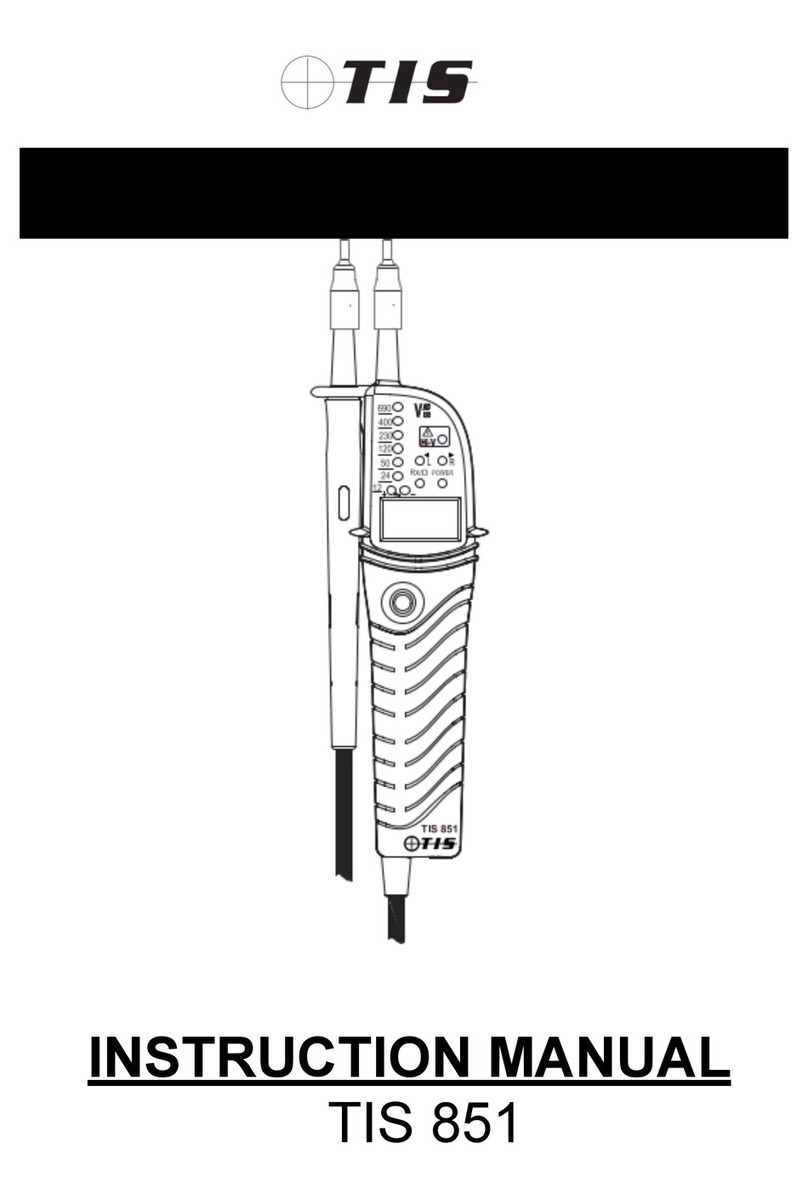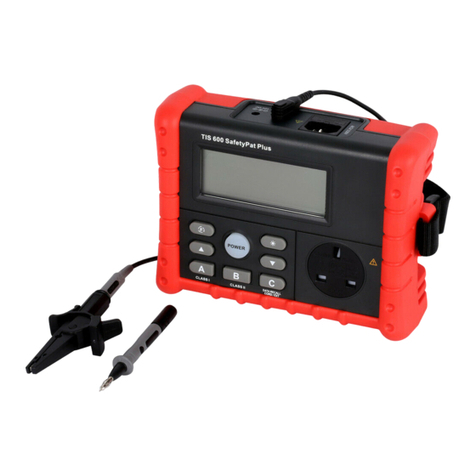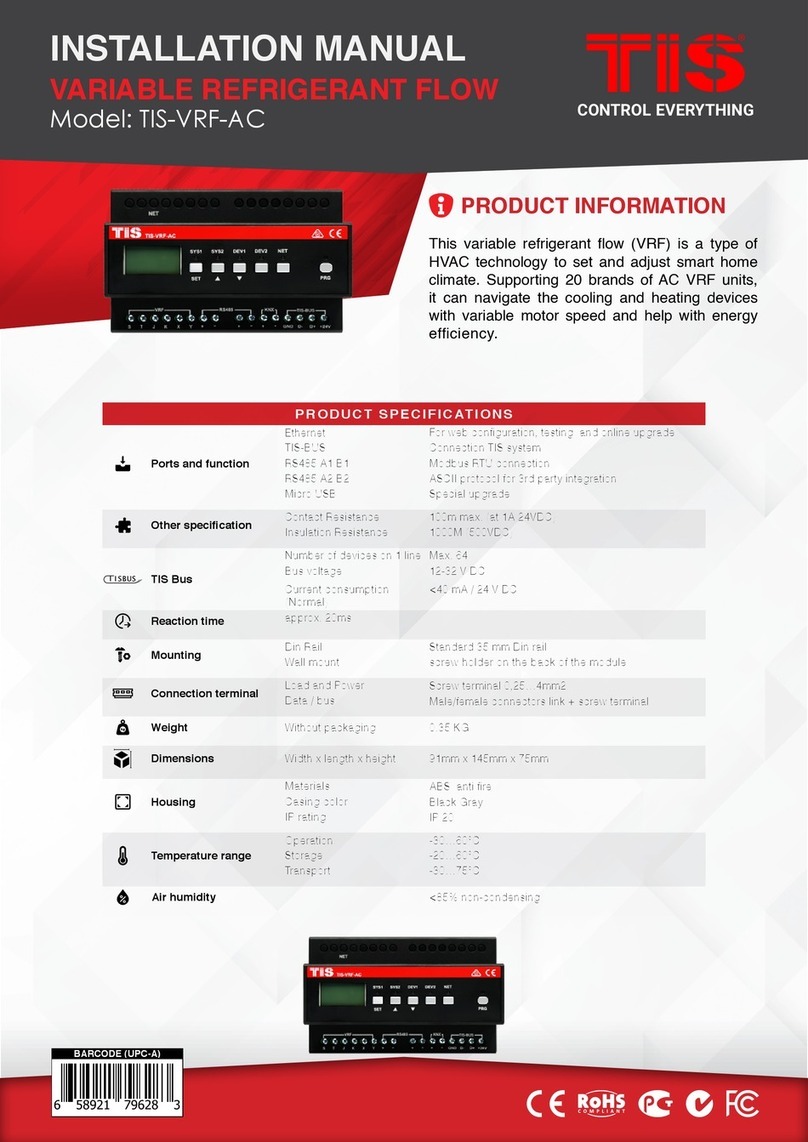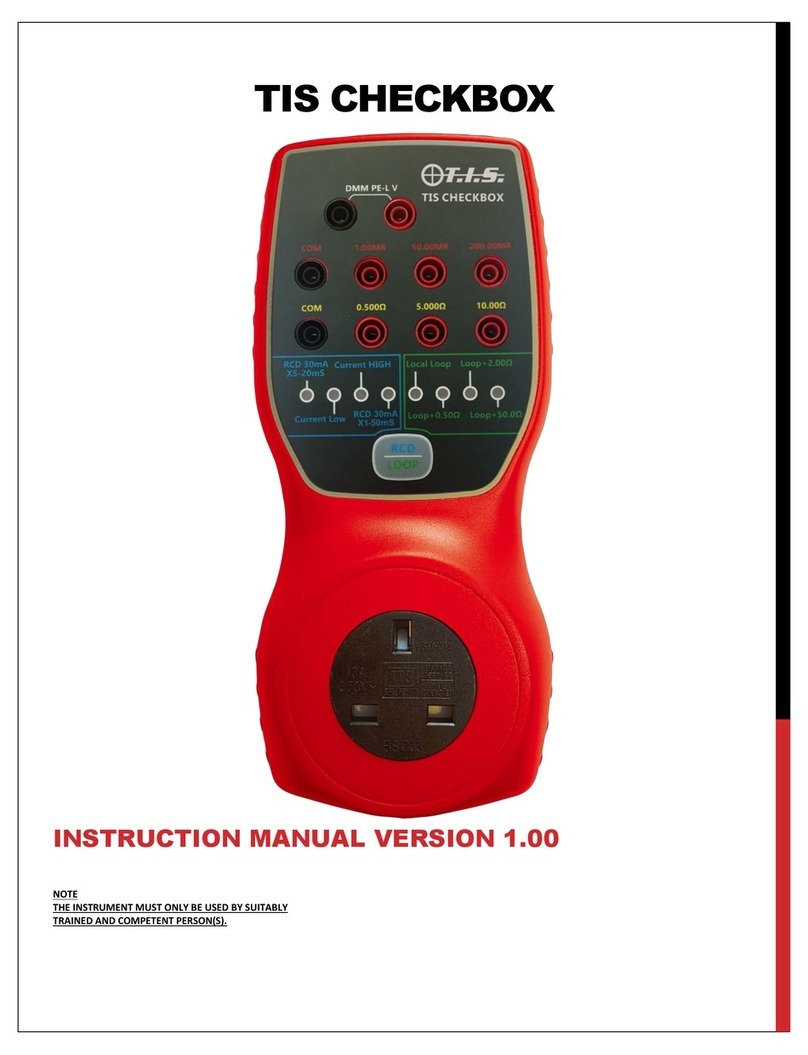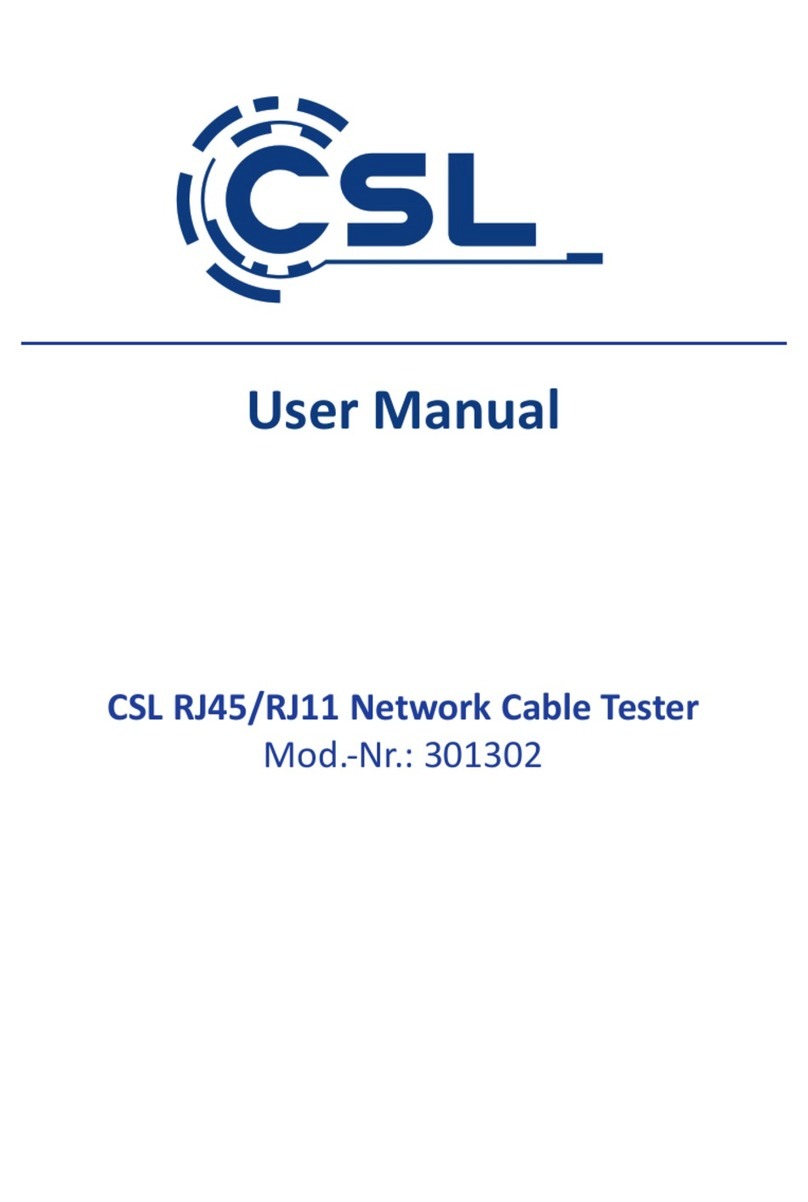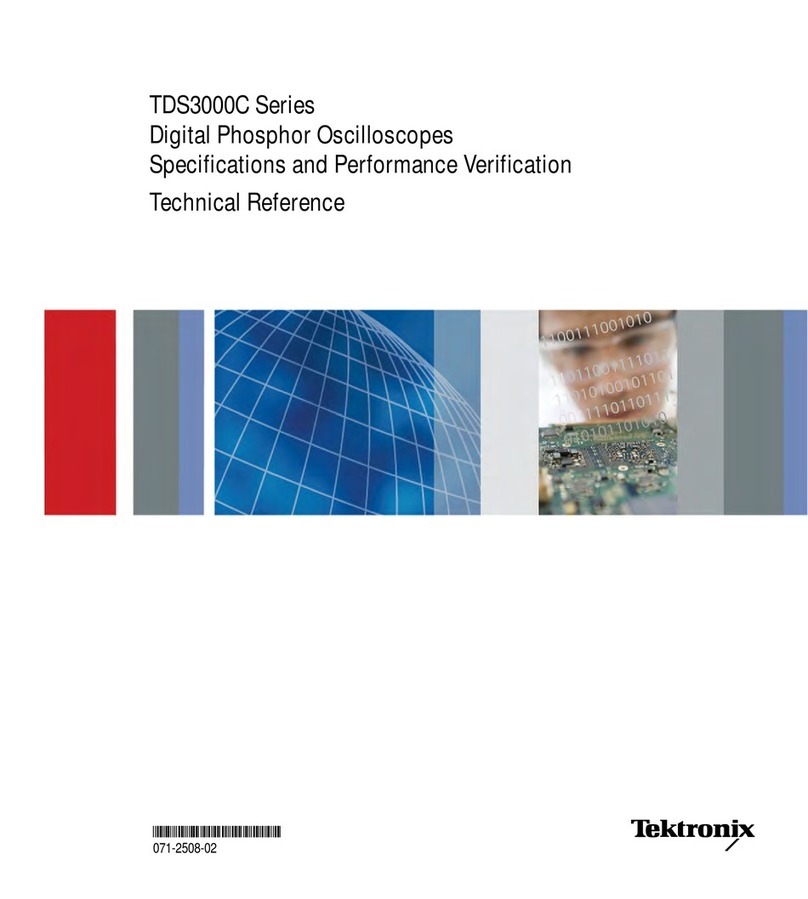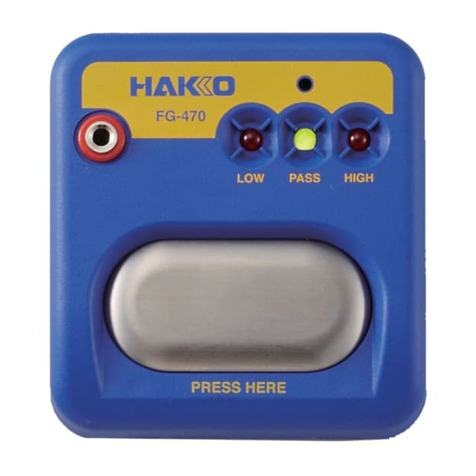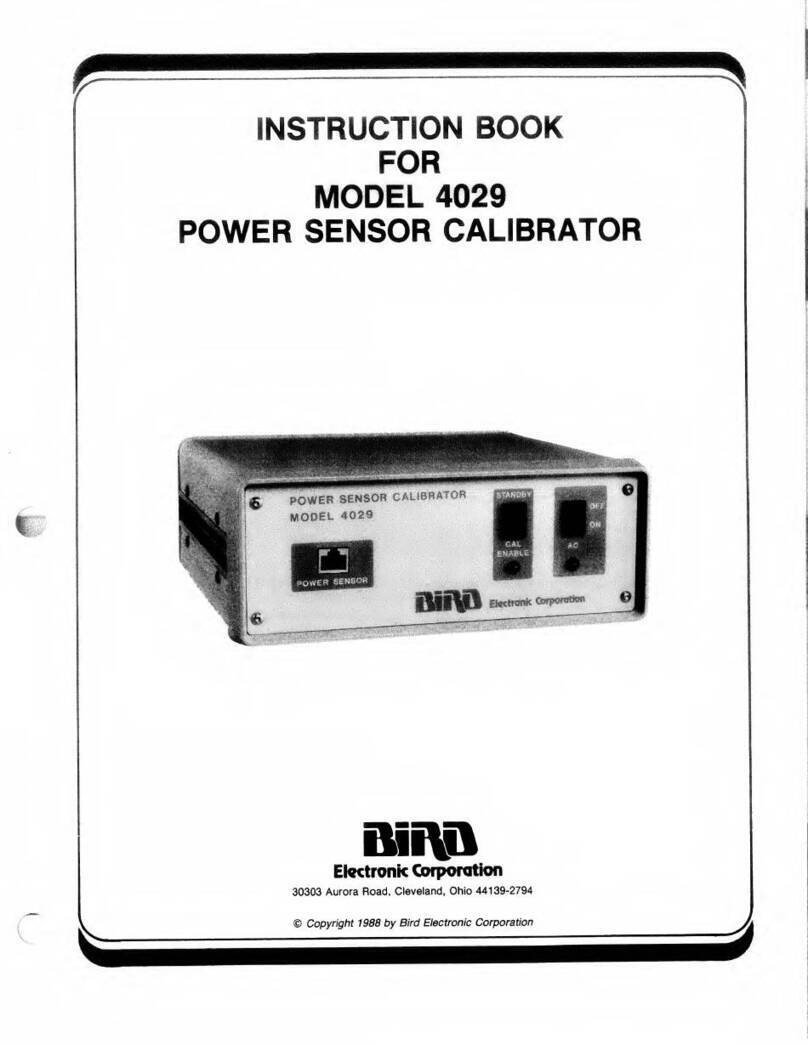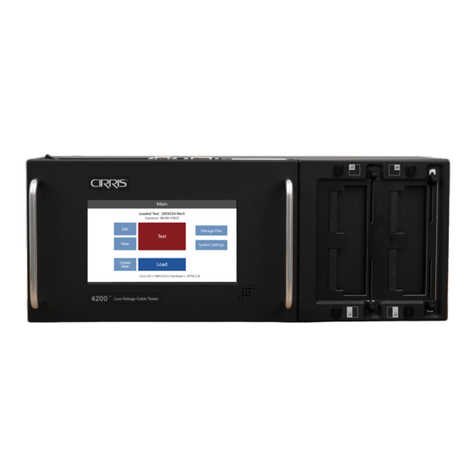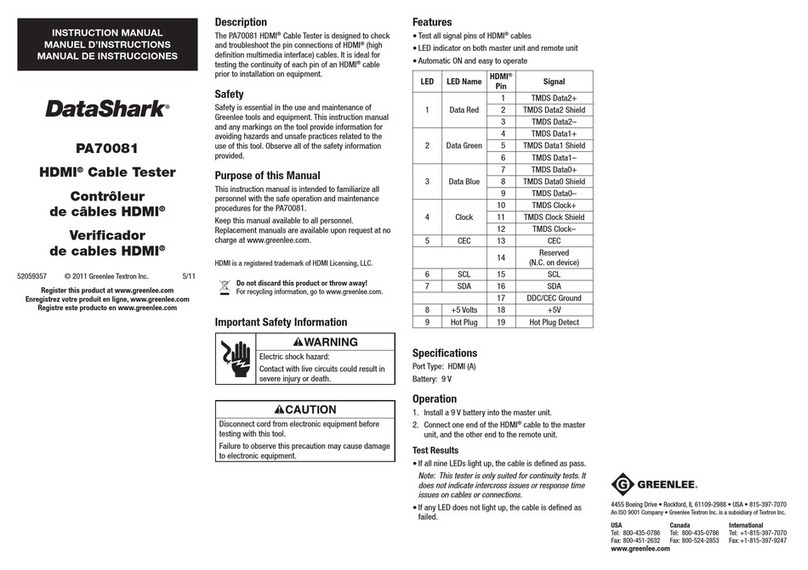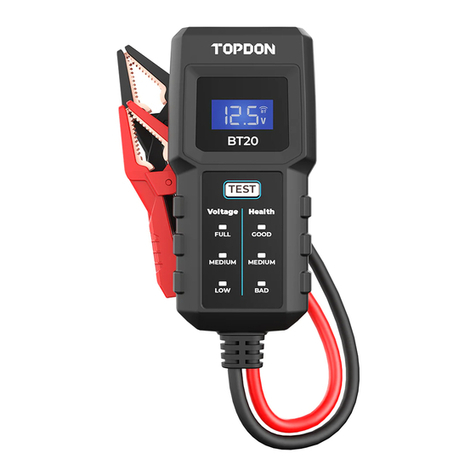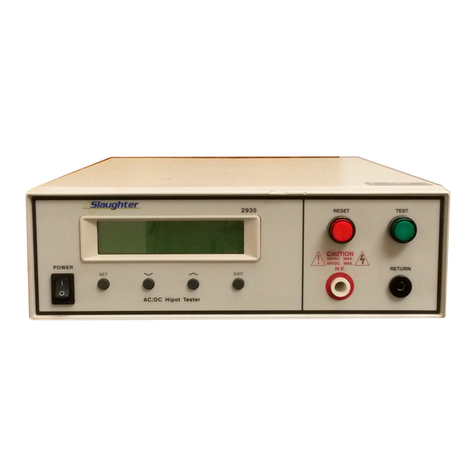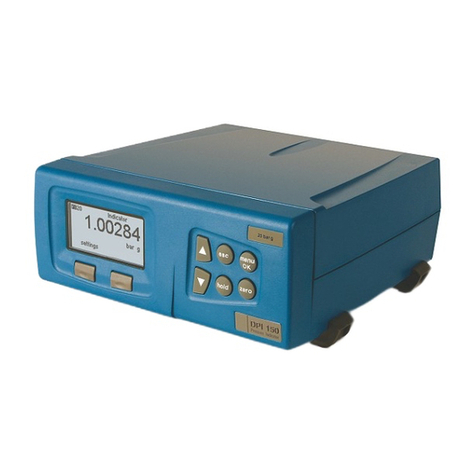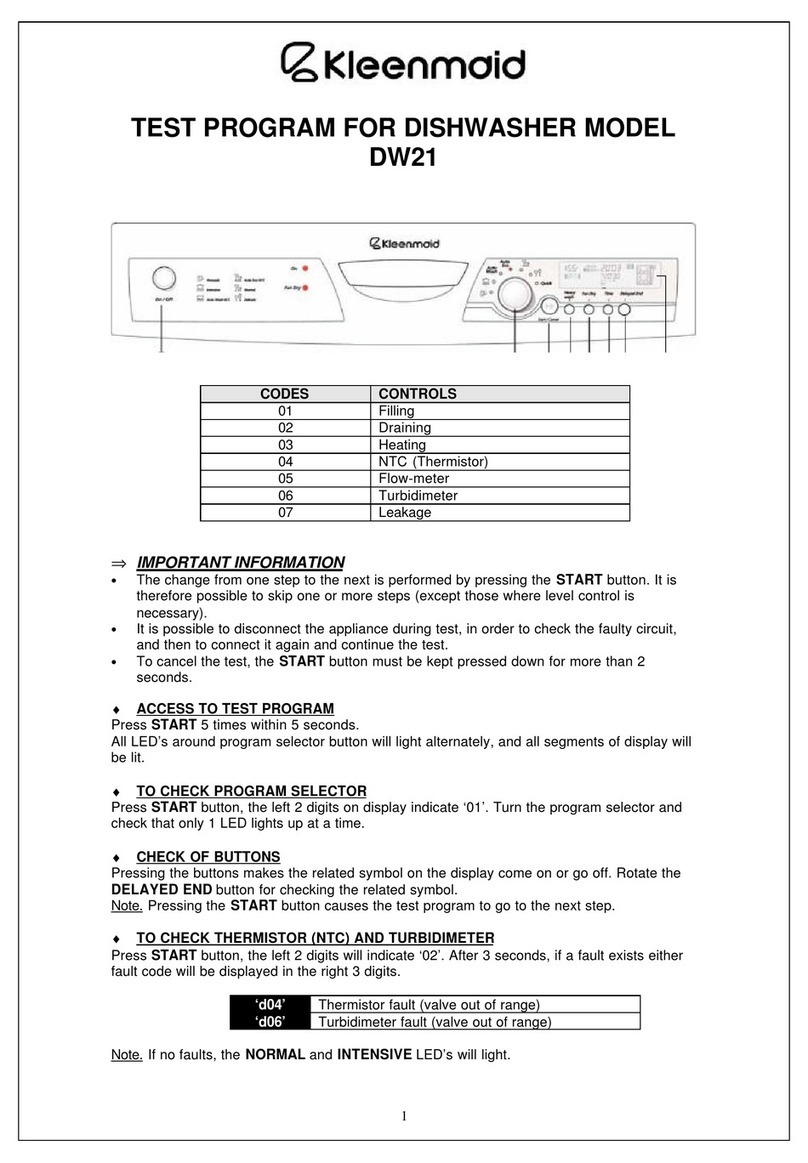TIS E237 User manual

TIS E237 & E247
Clamp-on Multimeter Series

1
1) SAFETY
This manual contains information and warnings that must be followed for operating the
instrument safely and maintaining the instrument in a safe operating condition. If the
instrument is used in a manner not specified by the manufacturer, the protection
provided by the instrument may be impaired.
The meter protection rating, against the users, is double insulation per
UL/IEC/EN61010-1 Ed. 3.0, IEC/EN61010-2-033 Ed. 1.0, CAN/CSA C22.2 No. 61010-
1 Ed. 3.0, UL/IEC/EN61010-2-032 Ed. 3.0 & UL/IEC/EN61010-031 Ed. 1.1:
Measurement Category III 600V & Category IV 300V AC & DC.
Per IEC61010-1 (2010) OVERVOLTAGE CATEGORY
OVERVOLTAGE CATEGORY ll (CAT II) is for equipment intended to be supplied
from the building wiring. It applies both to plug-connected equipment and to
PERMANENTLY CONNECTED EQUIPMENT.
OVERVOLTAGE CATEGORY lll (CAT III) is for equipment intended to form part of a
building wiring installation. Such equipment includes socket outlets, fuse panels, and
some MAINS installation control equipment.
OVERVOLTAGE CATEGORY lV (CAT IV) is for equipment installed at or near the
origin of the electrical supply to a building, between the building entrance and the main
distribution board. Such equipment may include electricity tariff meters and primary
overcurrent protection devices.
TERMS IN THIS MANUAL
WARNING identifies conditions and actions that could result in serious injury or even
death to the user.
CAUTION identifies conditions and actions that could cause damage or malfunction
in the instrument.
WARNING
To reduce the risk of fire or electric shock, do not expose this product to rain or
moisture. The meter is intended only for indoor use.
To avoid electrical shock hazard, observe the proper safety precautions when working

2
with voltages above 60 VDC or 30 VAC rms. These voltage levels pose a potential
shock hazard to the user. Before and after hazardous voltage measurements, test the
voltage function on a known source such as line voltage to determine proper meter
functioning.
Keep your hands/fingers behind the hand/finger barriers (of the meter and the test
leads) that indicate the limits of safe access of the hand-held part during measurement.
Inspect test leads, connectors, and probes for damaged insulation or exposed metal
before using the instrument. If any defects are found, replace them immediately. Only
use the test lead provided with the equipment or UL Listed Probe Assembly rated CAT
III 600V or better.
This Clamp-on meter is designed to apply around or remove from uninsulated
hazardous live conductors. But still, individual protective equipment must be used if
hazardous live parts in the installation where measurement is to be carried out could
be accessible.
CAUTION
Disconnect the test leads from the test points before changing meter functions.
INTERNATIONAL ELECTRICAL SYMBOLS
! Caution ! Refer to the explanation in this Manual
Caution ! Risk of electric shock
Earth (Ground)
Double Insulation or Reinforced insulation
Fuse
AC--Alternating Current
DC--Direct Current
Application around and removal from hazardous live conductors is permitted
2) CENELEC Directives
The instruments conform to CENELEC Low-voltage directive 2014/35/EC,
Electromagnetic compatibility directive 2014/30/EU and RoHS directive 2011/65/EU.
3) PRODUCT DESCRIPTION
This user's manual uses only representative model(s) for illustrations. Please refer
specification details for function availability to each model.

3
1) Antenna area for Non-Contact
EF-Detection
2) Jaw center indicator (with DCA
polarity for TIS E247 only), at
where best current accuracy is
specified
3) Rotary Selector to turn the
power ON/OFF and Select a
function
4) 3-5/6 digits 6000 counts numeric
LCD display
5) Additional input Jack for Phase
Rotation function only
6) Input Jack for all functions
EXCEPT non-invasive DCA,
DC+ACA, or ACA current
functions
7) Common (Ground reference)
Input Jack for all functions
EXCEPT non-invasive DCA,
DC+ACA, or ACA current functions
8) Push-buttons for special
functions & features.
9) Jaw trigger for opening the
clamp jaw
10) Hand/Finger Barrier to indicate
the limits of safe access of the
meter
11) Clamp Jaw for DC or AC
current magnetic field pick up
12) Additional center indicator for AmpTipTM Low-current function, at where best
AmpTipTM current accuracy is specified

4
4) OPERATION
WARNING: Before and after hazardous voltage measurements, test the voltage
function on a known source such as line voltage to determine proper meter functioning.
ACV, DCV, DC+ACV (Model TIS E247 only), Line-level Hz, & EF (NCV) functions
Inputs, other than that of EF as described below, are made through the test lead
terminals COM/+. Defaults at ACV* Function. Press SELECT button momentarily to
select DCV, DC+ACV, Line-level Hz or EF (NCV) function in sequence.
Note:
*ACV (and hence AC+DCV & Line-level Hz) function is equipped with digital low-pass
filter, and is capable of dealing with VFD (Variable Frequency Drives) signals. It also
improves ACV reading stability in noisy electrical environments.

5
Electric Field EF-Detection
The meter displays “EF” when it is ready. Signal strength is indicated as a series of
bar-graph segments on the display together with variable beep tones.
●Non-Contact EF-Detection: An antenna is located along the top-right end of the
stationary clamp jaw, which detects electric field surrounds energized conductors. It is
ideal for tracing live wiring connections, locating wiring breakage and to distinguish
between live or earth connections.
●Probe-Contact EF-Detection: For more precise indication of live wires, such as
distinguishing between Live and Ground connections, use one single probe to test via
terminal COM for direct contact EF-Detection with best sensitivity.

6
CAUTION & WARNING for Non-Invasive (Clamp-on) Current Measurements:
CAUTION
(Application and Removal of the Clamp-on Jaws) For non-invasive current
measurements, press the jaw trigger and clamp the jaws around conductor(s) of only
one single pole of a circuit for load current measurement. Make sure the jaws are
completely closed, or else it will introduce measurement errors. Enclosing conductor(s)
of more than one pole of a circuit may result in differential current (like identifying
leakage current) measurement. Align the conductor(s) to the Jaws center indicators
(Regular or AmpTip™ indicators where applicable) as much as possible to get the best
measuring accuracy. For removal, press the jaw trigger and remove the jaws from the
conductor(s).
Adjacent current-carrying devices such as transformers, motors and conductor wires
may affect measurement accuracy. Keep the jaws away from them as much as
possible to minimize influence.
WARNING
Do not use the meter to measure currents above the rated frequency (400Hz).
Circulating currents may cause the magnetic circuits of the Jaws reach a hazardous
temperature.

7
Non-Invasive AmpTipTM Low-Current Functions:
ACA, DCA (Model TIS E247 only), DC+ACA (Model TIS E247 only), & Hz
Input is made via the clamp jaws with best accuracy specified near the jaw tip area for
small conductors low-current measurements. Defaults at ACA function. Press SELECT
button momentarily to select the subject functions in sequence.

8
Non-Invasive Regular Current Functions:
ACA, DCA (Model TIS E247 only), DC+ACA (Model TIS E247 only), & Hz
Input is made via the clamp jaws with best accuracy specified at the jaw center for
regular current measurements. Press SELECT button momentarily to select the
subject functions in sequence.

9
Resistance, Continuity, & Diode functions
Inputs are made through the test lead terminals COM/+. Defaults at Resistance.
Press SELECT button momentarily to select the subject functions in sequence.
Note
When using Diode test function, normal forward voltage drop (forward biased) for a
good silicon diode is between 0.400V to 0.900V. A reading higher than that indicates a
leaky diode (defective). A zero reading indicates a shorted diode (defective). An OL
indicates an open diode (defective). Reverse the test leads connections (reverse
biased) across the diode. The digital display shows OL if the diode is good. Any other
readings indicate the diode is resistive or shorted (defective).
CAUTION
Using Resistance, Continuity or Diode function in a live circuit will produce false results
and may damage the meter. In many cases, the suspected component(s) must be
disconnected from the circuit to obtain an accurate measurement reading.

10
Capacitance, & Temperature functions
Inputs are made through the test lead terminals COM/+. Defaults at Capacitance.
Press SELECT button momentarily to select oC (Celsius) or oF (Fahrenheit) in
sequence.
Note
Be sure to insert the banana plug type-K temperature bead probe with correct
polarities. You can also use a plug adapter (Optional purchase) with banana pins to
type-K socket to adapt other type-K standard mini plug temperature probes.
CAUTION
1. Using Capacitance function in a live circuit will produce false results and may
damage the meter. In many cases the suspected component(s) must be disconnected
from the circuit to obtain an accurate measurement reading.

11
2. When using Capacitance function, discharge capacitor(s) before making any
measurements. Large value capacitors should be discharged through an appropriate
resistance load
DCA Current function
Inputs are made through the test lead terminals COM/+.
Application notes:
The DCA function is designed especially for HVAC/R flame sensor applications. The
0.1A resolution is useful for identifying the minute current changes in flame detector
applications. Flame signal current check should indicate steady flame signal of at least
2A for a rectification type, or 1.5A for an ultraviolet type (8A for self checking
systems). If a flame signal current with inadequate strength or fluctuation beyond 10%,
check the following to avoid the risk of unwanted flame relay dropout :
For gas or oil flames (Minipeeper):
Low supply voltage
Detector location
Defective detector wiring
Dirty viewing windows
Faulty Minipeeper
For oil flames (Photocell):
Detector location & wiring
Smoky flame or poorly adjusted air shutter
Faulty Photocell
Temperature over 165 oF (74 oC) at photocell
For gas flames (Flame Rod):
Ignition interference (A flame signal current difference with the ignition both on and
off greater than 0.5A indicates the presence of ignition interference)
Insufficient ground (must be at least 4 times the detector area)
Flame lifting off burner head (ground), or not continuously in contact with the flame
rod
Temperature in excess of 600 oF (316 oC) at the flame electrode insulator causing
short to ground.

12
& 3-Phase Rotation function
Inputs are made through the test lead terminals L1/L2/L3. Phase Rotation directions
are indicated as symbolic movements by the LCD segments. Defaults at . Press
SELECT button momentarily toggles between and modes.
: Hi-sensitivity mode, which detects relatively low signal outputs generated from
motor spinning, for checking phase connections of Motors.
: Normal-sensitivity mode for identifying phase sequence of MAINS (electricity
supply).
CAUTION
Proper Rotation detection relies on solid signal connection to all three test lead
terminals simultaneously. Any single disconnection will lead to detection failure and
may produce false indication. To verify signal connection and hence proper meter
indication, swap any two connects (between the meter and the test points) to check for
indication of reverse movement

13
Using the Hi-sensitivity mode for Motors:
Connect to the Motor as illustrated. Be sure the electricity supply is removed. From the
perspective of looking down the shaft of the motor, speed-spin it clockwise to generate
sufficient signal strength for proper meter detection. If the meter indicates a clockwise
movement, the motor leads connected to L1, L2 and L3 of the meter are L1, L2 and L3
(also known as R, S and T), respectively. If the meter indicates a counter-clockwise
movement, swap any two connects between the meter and motor. Then retest.
Using the Normal mode for MAINS (electricity supply):
Connect to the MAINS as illustrated. If the meter indicates a clockwise movement, the
phases connected to L1, L2 and L3 of the meter are L1, L2 and L3 (also known as R, S
and T), respectively. If the meter indicates a counter-clockwise movement, swap any
two connects between the meter and phases. Then retest. Connect the above
mentioned L1, L2 and L3 of a Motor and that of the MAINS respectively should get a
clockwise motor movement.
Using the Complementary Beeper feature:
The Complementary Beeper feature is selected in Power-up option. Press and hold the
REC button while turning the meter on to enable. If the segments indicate a clockwise
movement, the beeper sounds a single long beep per segment cycle. If the segments
indicate a counter clockwise movement, the beeper sounds 3 short beeps per segment
cycle.
Hold
Hold feature freezes the display for later view. LCD “ ” turns on. Press the HOLD
button momentarily to toggle the hold feature.
Record mode
Press REC button momentarily to activate MAX/MIN/AVG recording mode. LCD “ ” &
“MAX MIN AVG” turn on. The meter beeps when new MAX (maximum) or MIN
(minimum) reading is updated. AVG (Average) reading is calculated over time. Press
the button momentarily to read the MAX, MIN and AVG readings in sequence. Press
the button for 1 second or more to exit this mode. Auto-Power-Off is disabled
automatically in this mode.
Relative-Zero ( ZERO) mode
Relative-Zero allows the user to offset the meter consecutive measurements with the
main display displaying reading as the reference value. LCD “ ” turns on. Press the

14
ZERO (HOLD) button for one second or more to toggle Relative-Zero mode.
DC-Zero mode is set instead of Relative-Zero mode, however, to only offset the non-
zero DCA residuals caused by magnetic hysteresis of the jaws as in DCA & DC+ACA
functions. Press the ZERO (HOLD) button for one second or more to activate/ re-
activate this mode. Apply this mode before making any single DCA or DC+ACA
measurement for best measuring accuracy. The meter shows “dc_0” shortly to confirm
activation before continuing measurements. The beeper will sound 3 short beeps,
however, to warn for null activation if the residual is beyond a reasonable hysteresis
reading of -5 to 5 DCA.
80ms PEAK-RMS mode
Press PEAK-RMS button for one second or more to toggle PEAK-RMS mode to
capture inrush current or voltage RMS values in duration as short as 80ms. LCD
turns on. Auto-Power-Off is disabled automatically in this mode.
Backlighted LCD display
Press the SELECT button for 1 second or more to toggle the LCD backlight. The
backlight will also be turned off automatically after 32 seconds to extend battery life.
Intelligent Auto-Power-Off (APO)
The Auto-Power-off (APO) mode turns the meter off automatically to extend battery life
after approximately 32 minutes of no specified activities, where applicable:
1) Rotary switch or push button operations
2) Significant measuring readings of above 8.5% of ranges
3) Non-OL readings for Resistance, Continuity or Diode function
4) Non-zero readings for Hz function
5) Significant movement indication as in Phase Rotation functions
In other words, the meter will intelligently avoid entering the APO mode when it is
under normal measurements. To wake up the meter from APO, press the SELECT
button momentarily and release, or turn the rotary switch OFF and then back on.
Always turn the rotary switch to the OFF position when the meter is not in use
5) MAINTENANCE
WARNING
To avoid electrical shock, disconnect the meter from any circuit, remove the test leads
from the input jacks and turn OFF the meter before opening the case. Do not operate
with open case.

15
Trouble Shooting
If the instrument fails to operate, check batteries and test leads etc., and replace as
necessary. Double check operating procedure as described in this user’s manual.
If the instrument voltage-resistance input terminal has subjected to high voltage
transient (caused by lightning or switching surge to the system under test) by accident
or abnormal conditions of operation, the protective impedance components in series
might be blown off (become high impedance) like open fuses to protect the user and
the instrument. Most measuring functions through this terminal might then be open
circuit. Such components should only be replaced by qualified technician. Refer to the
LIMITED WARRANTY section for obtaining warranty or repairing service.
Accuracy and Calibration
Accuracy is specified for a period of one year after calibration. Periodic calibration at
intervals of one year is recommended to maintain meter accuracy. Refer to the
LIMITED WARRANTY section for obtaining calibration, repairing or warranty service.
Cleaning and Storage
Periodically wipe the case with a damp cloth and mild detergent; do not use abrasives
or solvents. If the meter is not to be used for periods of longer than 60 days, remove
the batteries and store them separately.
Battery replacement
The meter uses standard 1.5V AAA Size (IEC R03) battery X 2
Loosen the 2 captive screws from the battery cover case. Lift the battery cover case.
Replace the batteries. Replace battery cover case. Re-fasten the screws.

16
GENERAL SPECIFICATIONS
Display: 3-5/6 digits 6000 counts.
Polarity: Automatic
Update Rate: 5 per second nominal;
Operating Temperature: 0C to 40C
Relative Humidity: Maximum relative humidity 80% for temperature up to 31C
decreasing linearly to 50% relative humidity at 40C
Pollution degree: 2
Storage Temperature: -20C to 60C, < 80% R.H. (with battery removed)
Altitude: Operating below 2000m
Temperature Coefficient: nominal 0.15 x (specified accuracy)/ C @(0C -- 18C or
28C -- 40C), or otherwise specified
Sensing: True RMS
Safety: Double insulation per UL/IEC/EN61010-1 Ed. 3.0, IEC/EN61010-2-033 Ed. 1.0,
CAN/CSA C22.2 No. 61010-1 Ed. 3.0, IEC/EN61010-2-032 Ed. 3.0 & IEC/EN61010-
031 Ed. 1.1 to CAT III 600V and CAT IV 300V AC & DC

17
Transient Protection: 6.0kV (1.2/50s surge)
Overload Protections:
Current & Hz functions via jaws: 600ADC/AAC rms at <400Hz
Voltage & 3-Phase Rotation functions via terminals: 660VDC / 920VAC rms
Other functions via terminals: 600VDC/VAC rms
E.M.C.: Meets EN61326-1:2006 (EN55022, EN61000-3-2, EN61000-3-3, EN61000-4-
2, EN61000-4-3, EN61000-4-4, , EN61000-4-5, EN61000-4-6, EN61000-4-8,
EN61000-4-11):
DCA and DC+ACA Functions, in an RF field of 1V/m:
Total Accuracy = Specified Accuracy + 20 digits at around 405MHz
DCA and Ohm Functions, in an RF field of 1V/m:
Total Accuracy = Specified Accuracy + 25 digits
Other Functions, in an RF field of 3V/m:
Total Accuracy = Specified Accuracy + 20 digits
Power Supply: 1.5V AAA Size battery X 2
Power Consumption: Typical 4.3mA
Low Battery:
Below approx. 2.85V for Capacitance & Hz
Below approx. 2.5V for other functions
APO Timing: Idle for 32 minutes
APO Consumption: 5A typical
Dimension (LxWxH): 217 x 76 x 37mm
Weight: 186gm
Jaw opening & Conductor diameter : 30mm max
Accessories: Test lead set, User's manual, Soft carrying pouch, banana plug K-type
thermocouple, Alligator Clip set
Optional purchase accessories: Banana plug to type-K socket plug adaptor
Special Features: AmpTipTM low-current range; MAX/MIN/AVG Recording mode;
Display Hold; EF-Detection (NCV); Backlighted LCD; 80ms Peak-RMS mode for inrush
current; Relative-Zero, 3-Phase Rotation detection

18
Electrical Specifications
Accuracy is (% reading digits + number of digits) or otherwise specified, at 23C
5C.
Maximum Crest Factor < 2.5 : 1 at full scale & < 5 : 1 at half scale or otherwise
specified, and with frequency spectrum not exceeding the specified frequency
bandwidth for non-sinusoidal waveforms.
DC Voltage
RANGE Accuracy
600.0V 1.0% + 5d
Input Impedance: 10M, 100 pF nominal
AC Voltage (with Digital Low-Pass Filter)
RANGE Accuracy
50Hz ~ 60Hz
600.0V 1.0% + 5d
Input Impedance: 10M, 100 pF nominal
DC+AC Voltage (with Digital Low-Pass Filter) (TIS E247 Only)
RANGE Accuracy
DC, 50Hz ~ 60Hz
600.0V 1.2% + 7d
Input Impedance: 10M, 100 pF nominal
PEAK-rms (ACV & ACA)
Response: 80ms to > 90%
Audible Continuity Tester
Audible Threshold: At between 10 and 250
Response time: 32ms approx.
Ohm
RANGE Accuracy
600.0, 6.000K, 60.00K 1.0% + 5d
Open Circuit Voltage: 1.0VDC typical

19
Capacitance
RANGE Accuracy 1)
200.0F, 2500F 2.0% + 4d
1)Accuracies with film capacitor or better
Diode Tester
RANGE Accuracy
2.000V 1.5% + 5d
Test Current: 0.3mA typically
Open Circuit Voltage: < 3.5VDC typically
DCA
RANGE Accuracy Burden Voltage
200.0A, 2000A 1.0% + 5d 3.5mV/A
Temperature
RANGE Accuracy
-40.0 oC ~ 99.9 oC 1.0% + 0.8oC
100 oC ~ 400 oC 1.0% + 1oC
-40.0 oF ~ 211.8 oF 1.0% + 1.5oF
212 oF ~752 oF 1.0% + 2oF
K-type thermocouple range & accuracy not included
AmpTipTM clamp-on ACA
RANGE Accuracy1) 2) 3) 4)
50Hz ~ 60Hz
60.00A 1.5% + 5d
1)Induced error from adjacent current-carrying conductor:
<0.06A/A
2)Specified with Relative Zero mode applied to offset the non-zero residual readings,
if any
3)Add 10d to the specified accuracy @ < 4A
4)Unspecified @ <0.2A
This manual suits for next models
1
Table of contents
Other TIS Test Equipment manuals
